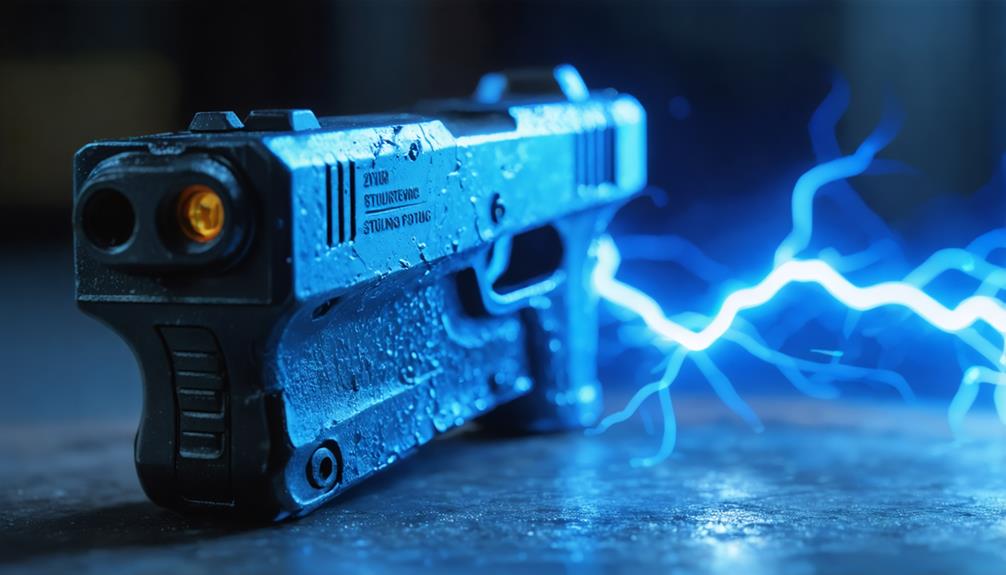
Brainstorm Security Shop

For Orders Over $199

On Any Of Our Products

Details On Refund Page
Stun guns serve as a compelling tool in personal defense by delivering electrical shocks that temporarily incapacitate an assailant. These devices operate by emitting high-voltage, low-amperage currents that disrupt an attacker’s neuromuscular system, leading to involuntary muscle contractions and temporary immobilization. While their effectiveness in thwarting threats is well-documented, understanding the intricacies of how stun guns achieve this and their legal implications can be crucial for responsible ownership. As we explore the science behind these devices and their societal perceptions, one might ponder how these factors influence their role in self-defense today.
When delving into the technology behind stun guns, it’s essential to comprehend the fundamental principles that govern their operation. At the core of stun gun mechanisms lies the concept of electrical discharge. Stun guns are designed to incapacitate a target temporarily by delivering a high-voltage, low-amperage electrical shock.
This electrical discharge is pivotal to the device’s functionality, as it disrupts the body’s neuromuscular system. The disruption is sufficient to cause involuntary muscle contractions, impairing the individual’s ability to move effectively and thus neutralizing potential threats without causing permanent harm.
The stun gun’s design typically involves two metal prongs, which serve as the conduits for the electrical discharge. When activated, the device generates an electric arc between these prongs. The resulting electrical current is then transmitted into the target upon contact.
This process is facilitated by a transformer and oscillator within the device, which convert the battery’s low-voltage power into the high-voltage output required for effective use.
In understanding stun gun technology, it becomes evident that the interplay between electrical components and biological effects is crucial. This knowledge underscores the importance of precise engineering in ensuring the stun gun’s efficacy and safety.
Stun guns come in various types, each designed to meet different needs and circumstances. These devices are popular for their self defense applications, offering individuals a non-lethal means to protect themselves.
The most common types of stun guns include handheld models, stun batons, and flashlight stun guns, each with unique features tailored to specific situations.
Handheld stun guns are compact and easy to carry, making them a popular choice for personal safety. Their small size allows for discreet storage in a purse or pocket, providing quick access in emergencies.
Stun batons, on the other hand, offer extended reach, which can be advantageous in deterring potential threats from a distance. These devices often include additional stun gun features such as built-in alarms or flashlights for added functionality.
Flashlight stun guns combine the practicality of a flashlight with the protective capability of a stun gun. This dual-purpose design is particularly useful in low-light conditions, ensuring visibility while remaining prepared for self-defense.
Additionally, some advanced models incorporate features like rechargeable batteries and safety switches, enhancing their reliability and ease of use. Each type of stun gun offers distinct advantages, allowing users to choose the most suitable tool for their personal protection needs.
The effects of stun guns on the human body primarily involve disrupting the neuromuscular system. When a stun gun is deployed, it emits an electrical charge that temporarily overrides the body’s voluntary muscle control. This disruption causes an immediate and involuntary contraction of muscles, leading to temporary immobilization. The physiological response to this electrical current is akin to a full-body muscle spasm, which can incapacitate an individual for several seconds.
Pain perception is another critical aspect of how stun guns affect the human body. The electrical discharge from a stun gun can induce a significant degree of pain, which varies with the voltage and duration of the exposure. The pain is often described as sharp and intense, contributing to the device’s effectiveness in subduing an aggressor. However, it is important to note that the pain is typically transient and subsides once the electrical current ceases.
While generally non-lethal, the use of stun guns can result in additional physiological responses, such as increased heart rate and elevated blood pressure. These responses are usually temporary and revert to baseline levels shortly after the cessation of the electrical stimulus, assuming the individual is otherwise healthy.
While understanding the physiological effects of stun guns is important, it is equally significant to consider the legal framework governing their use. Stun gun regulations vary widely across jurisdictions, making it crucial for individuals to familiarize themselves with the specific legal restrictions in their area. These regulations can encompass ownership, usage, and carrying privileges, often influenced by local crime rates and public safety concerns.
In some regions, stun guns are classified as firearms, subjecting them to stringent control measures similar to those for handguns. Conversely, other areas may permit their unrestricted use. Below is a table summarizing various stun gun regulations across selected regions:
| Region | Ownership Requirement | Usage Restriction |
|---|---|---|
| California | Permit required | Restricted in public spaces |
| Texas | No permit needed | Prohibited in schools |
| New York | Prohibited | N/A |
| Florida | No permit needed | Legal for self-defense only |
| Illinois | FOID card required | Restricted in public transport |
Understanding these legal restrictions is vital for responsible ownership and usage. Violating stun gun regulations can result in severe penalties, including fines, confiscation, or even criminal charges. Therefore, potential users must conduct thorough research and, if necessary, seek legal advice to ensure compliance with all applicable laws.
When selecting the right stun gun, several key factors should be taken into consideration to ensure effectiveness and safety. One of the primary considerations is the range of stun gun features available. Features such as voltage output, size, and design can significantly impact the device’s usability and portability.
Higher voltage typically equates to more stopping power, but it is essential to balance power with control to prevent accidental injuries. Compact designs may be preferable for ease of carrying, while larger models might offer additional grip and control.
Furthermore, the choice of stun gun brands can greatly influence both quality and reliability. Established brands often have a reputation for producing durable and effective devices, providing peace of mind to users.
It is advisable to research customer reviews and expert recommendations to identify which brands consistently deliver reliable performance.
Additionally, consider any additional features such as built-in flashlights or alarms, which can enhance personal security beyond the primary function of the stun gun.
Ultimately, the right choice will depend on individual needs and preferences, ensuring that the user feels both safe and confident in their ability to use the device effectively when necessary.
The effectiveness of stun guns for self-defense against animals is contingent upon various factors, including the specific animal behavior and species. While potentially effective, their utility is limited and should be used cautiously, considering ethical and safety concerns.
Stun gun efficiency can be compromised by environmental factors such as extreme temperatures, humidity, and precipitation. These conditions may affect battery performance and electrical conductivity, potentially reducing the device’s effectiveness in delivering the intended incapacitating charge.
Proper maintenance of a stun gun involves regular battery replacement and performance testing to ensure optimal functionality. Consistent checks help identify potential issues early, maintaining the device’s reliability and effectiveness in various operational conditions.
Prolonged exposure to stun guns may pose health effects, including neuromuscular disruption and cardiac risks. Legal implications arise from misuse, as extended use can lead to serious injury or death, necessitating adherence to regulations and guidelines.
Stun gun technology is designed to incapacitate without causing electronic interference. However, concerns exist about potential disruptions to nearby electronic devices. Users should be cautious, as specific situations may lead to unintended effects on sensitive equipment.
